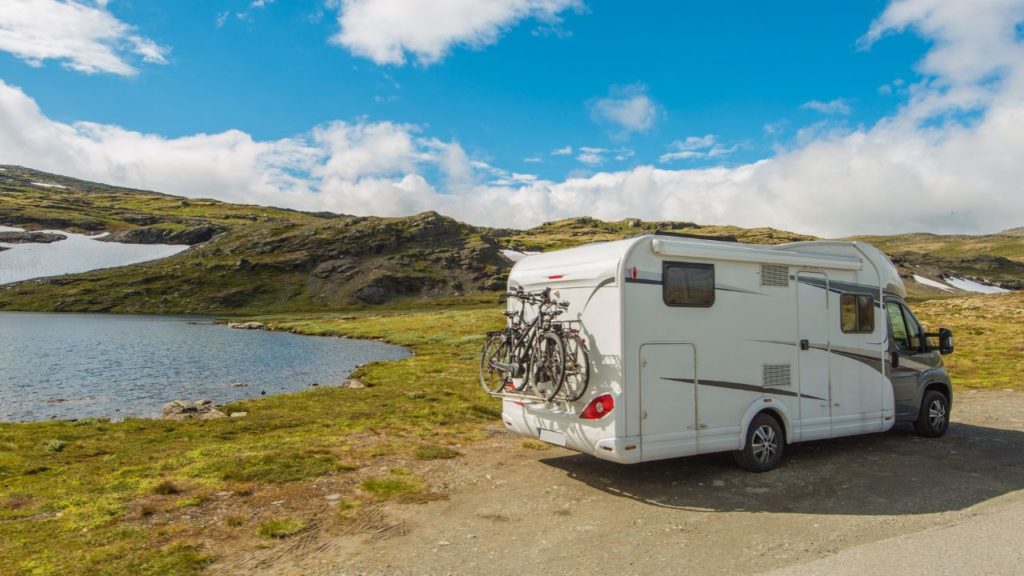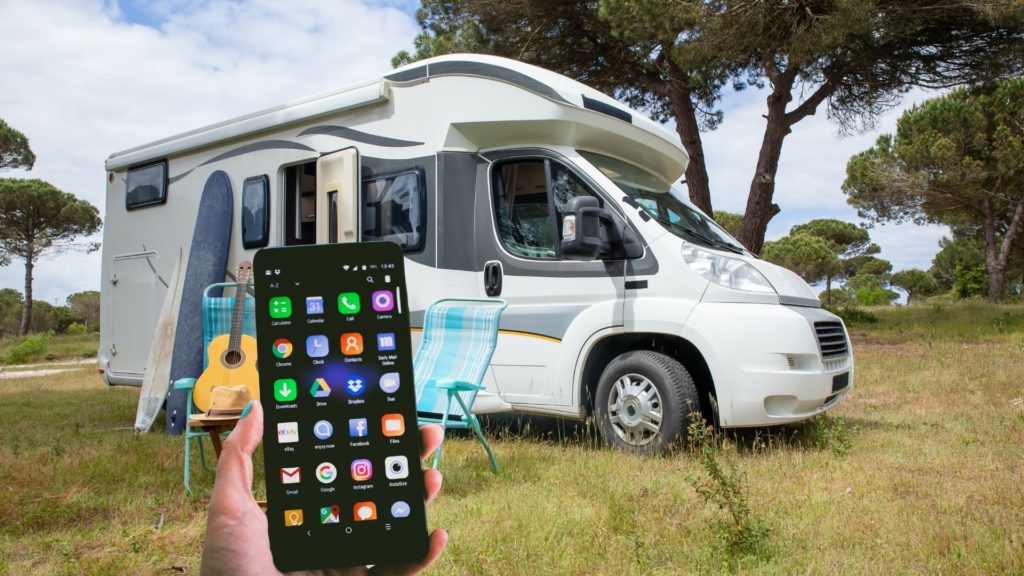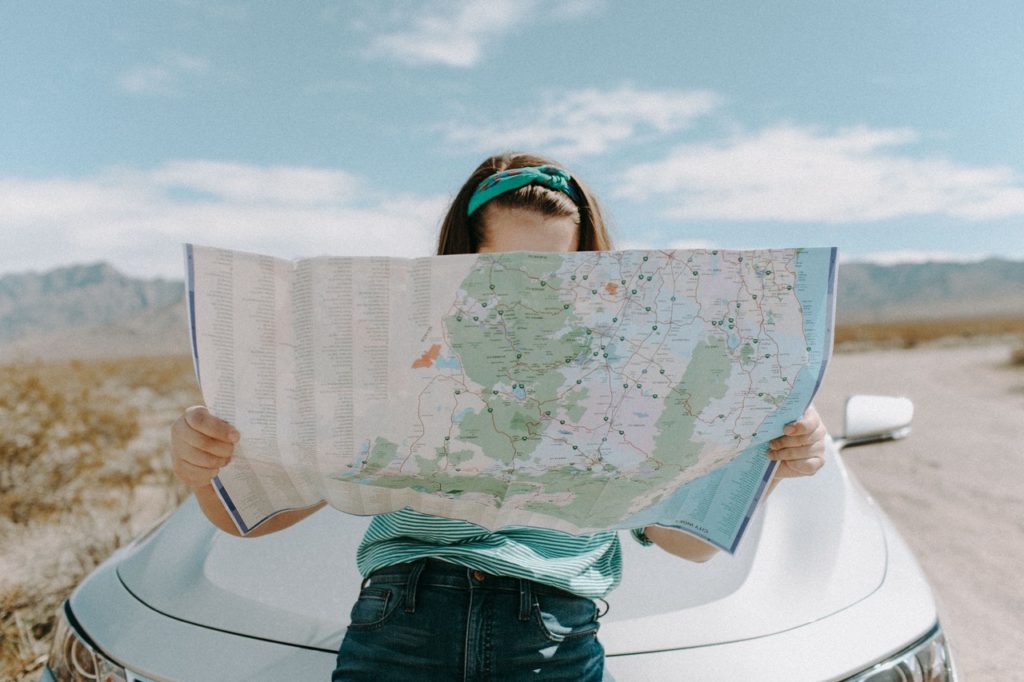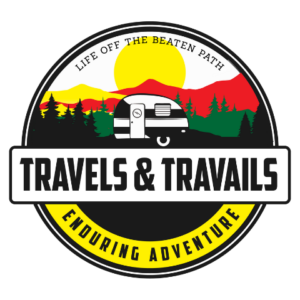
Overcrowded campgrounds have to lead many people to want to learn the ins and outs of dispersed camping. Dispersed camping gives you the freedom to camp in peace and quiet in beautiful places. But how do you find these coveted dispersed camping spots?
Here are 5 ways you can find dispersed camp sites:
- Apps
- National Forest/BLM Websites
- Google Maps
- Ranger Station
- Paper Maps
Read on to find out about ways to find dispersed campsites. If you aren’t sure what dispersed camping entails, read about it here.
Apps
There are several apps to help you find dispersed campsites. You may need to use several apps to find coveted secret sites. Here are ten apps and websites that you can use to find dispersed campsites:
- Campendium
- The Dyrt
- iOverlander
- Freeroam.com
- Boondocking
- Freecampsites.net
- Gaia
- OnX
- Overland Bound One
- US Public Lands
Campendium
Campendium.com is my favorite app for finding any kind of campsite. Campendium is a free app that you can use to find all kinds of camping options, including dispersed camping. I like it because it’s simple to use. Just type in the area where you would like to camp and sort by price (choose $0).
Campendium will deliver a list of all the free sites, which includes dispersed campsites. Other types of free camping, like Walmart camping, will be displayed. Scroll on through to the good stuff.
Campendium gives you the camp location, including GPS coordinates. You can use the website or the app version of Campendium. Both have the same information.
When you find a campsite, you’ll see a link to the website, whether that be the National Forest or the Bureau of Land Management (BLM). Campendium gives you the camp location, including GPS coordinates. Clicking on the GPS coordinates takes you to your Maps app so you can navigate to the destination location.
The app will note maximum RV length, maximum stay length, and elevation.
You’ll have to read through the reviews to find out more about the campsite. The review may also tell you if the site has a cell phone signal.
When looking at reviews, you’ll want to check the road conditions. Some roads may require four wheel drive or high clearance, so it’s important to take note of this.
Dispersed sites may have a fire ring, but normally lack any other type of amenity.
iOverlander
iOverlander is another free resource for dispersed camping. It’s my second choice if I can’t find anything on Campendium. While it features dispersed campsites, it also has other information like campground and dump site information.
Simply type either the city or the GPS coordinates and you’ll get a list of sites. If you don’t want the ancillary information, you can select only “wild” campsites.
There is a website as well as an app. Both have the same information.
The information is added by campers, so you will definitely need to double check to make sure that sites are actually approved for dispersed camping. However, it is chock full of handy information.
As I mentioned, the information is added by campers. iOverlander will tell you when the information was added, as things can change. The GPS coordinates and altitude will always be available, but other information might be different depending upon who posts to the site.
There is a place for the poster to list amenities and add photos. Frequently you’ll get an idea of road conditions, i.e. if the road is paved or dirt. Some posters will let you know if the site requires high clearance or four-wheel drive to get into it.
iOverlander is a good resource if you are dispersed camping outside the US.

Free Roam
If you can’t find what you are looking for on Campendium or iOverlander, try Free Roam.
freeroam.app gives you a map view with campsites. Zoom in to see more campsites in a particular area. You can also type in the area where you would like to camp. The orange-colored sites are free sites. Some of those campsites are dispersed sites.
At the top of the app or website, you can filter for price so that the map shows only free campsites. After that, you’ll have to search through the listed campsites to find the dispersed sites.
Like iOverlander, Free Roam information is entered by users. Unlike iOverlander and Campendium, Free Roam gives you weather averages by month. It also gives cell phone signal strength if the user entered this information.
You’ll get some general information about the site like the noise and safety levels if the information has been entered. Users can also upload photos.
You can access freeroam.app on the web or via the app.
Boondocking (app)
The boondocking app is similar to iOverlander in that the information is input by campers. It has a colorful interface with well-marked campsites. It does have sites that are not dispersed camping, like parking lots, etc.. Like iOverlander, you’ll have to verify that the site is a legal place to camp.
The campers who enter the information into the app are giving a review, so is a limited amount of consistent information. You will get a location or approximate location, GPS coordinates, and elevation information.
Freecampsites.net
Freecampsites.net is a website that includes free campsites (as the name implies) including dispersed camping. Like the other apps, you enter your destination information into the site and it will give you free camping locations in that area.
For whatever reason, it does also include paid campsites, but those are conveniently displayed in red. Free campsites are shown with a green tent icon. Clicking on that icon gives you the location, a link to open a map to get there, GPS coordinates, elevation, and the 5-day forecast.
Users submit reviews of the area and they are free to say whatever they want so it’s not very consistent. Still, the information is normally helpful as they sometimes give their rig length, cell signal and general conditions.

Gaia GPS
One of the disadvantages of the apps that we have discussed so far is that, if don’t have a cell phone signal, the app won’t work. With the paid version of Gaia GPS, you can download maps in advance so that you can still navigate to your site without a cell signal. You CAN use Gaia for free, but you won’t have the offline use.
Gaia GPS is really a navigation app, but it can be used to find campsites.
To hone in on a location, type in the name of that destination.
Gaia works with map layers and many more layers are available with the paid version. The Motor Vehicle Use Maps (MVUM), which will discuss in a minute, come standard with the paid version. To use the app offline, maps must be downloaded while you still have cell signal or WiFi.
You can use Gaia on the computer and as an app on your phone. It’s nice to do planning on the computer version since it’s a bigger window.
Overlaying the MVUMs with the Google Earth view will help you locate dispersed campsites. Gaia also has a map layer for property ownership. The layer is called “private land.” With this layer, you can tell if a property is National, Forest BLM or private property.
Once you find an area of interest, you can drop a pin so you can navigate to that location. As with other apps, be sure to have alternatives in case the site is taken.
OnX Offroad
While Gaia GPS was initially designed as a hiking app, OnX Offroad was designed for off-road travel. Like Gaia, OnX Offroad is also a travel app. However, there is no free version. To use OnX Offroad, you’ll have to pay the annual fee.
OnX Offroad does have a 7-day free trial. Beyond that, you’ll have to choose between the premium and elite packages. The main difference, when it comes to finding campsites, is that the elite package shows the property ownership boundaries and the premium package does not.
Like Gaia, OnX Offroad allows you to view the apps when you don’t have cell phone signal. Maps must be downloaded while you have cell or wifi signal.
OnX has an advantage over Gaia in that they have campsites posted on the map. Many of these are dispersed campsites. If you click on the camping icon a window opens to tell you where the site is located. The location includes GPS coordinates and tells you who owns the land, whether that be National Forest or BLM.
Like Gaia, OnX Offroad has a search function so that you can plan as well as find a camping location on the fly.
Roads that lead to the campsite are marked as well. Click on the trail (colored green or orange) to find out if your rig is equipped to handle the marked road.
As with many of the apps, the information is not always up to date. Always scout roads prior to bringing your rig into an unfamiliar area.
Overland Bound One
The Overland Bound One app has a free version which includes campsites. With the free version, you’ll get GPS coordinates for the campsites, but no description. Some will have reviews. Not all campsites are free, dispersed sites, so you’ll have to look through them. Some sites will require high clearance or four wheel drive.
US Public Lands
US Public Lands is a paid app but it only costs $2.99. It shows all the public land area in color. There is a different color for each type of public land. This is great for making sure that your site is on public land and not private land. Your location is notated by a blue dot, similar to Google Maps. That way, you can see where you are.

National Forest/BLM Websites
National Forest and BLM websites are great resources to find out more about camping in a particular area. The websites give you information about dispersed camping. For example, the sites will tell you the rules about where you can camp and the length of time you can camp in a location.
Motor Vehicle Use Maps (MVUM) are National Forest maps that show areas where land is owned by the National Forest Service. Be sure to download the maps ahead of time in case you don’t have a cell signal in the area where you are searching for a site. Some MVUMs have a legend that delineates roads where camping is permitted.
The National Forest also has an app called “National Forest Explorer” that you can download to your phone or device. You can select the forest location where you are interested in camping. The app provides information about that particular forest. It’s the same information that you can get on the web, but in a handier format.
Google Maps
Google maps helps navigate to sites, but it also serves another purpose. If you change Google Maps to the satellite view, you can see an overhead view of potential campsites.
If you are already in an area where you would like to camp, check out the satellite view of Google Maps for camp locations. They are obvious because they are generally a wide area that will be located off a dirt or forest road. If you find a camping location from an app, Google Maps helps you verify that the site looks like a legitimate site.
Google Maps gives you the option of dropping a pin on a site that looks promising so that you can navigate there. You can also pin multiple sites in case the site is taken or it’s not what you were looking for.
Ranger Station
Another way to find a site is to call or visit the ranger station. Last year, we planned a trip that I wasn’t certain our travel trailer could navigate. When we got to the location, I went to the ranger station. As it turns out, one of the roads that we wanted to travel was impassable with our travel trailer. The ranger gave an alternative route and we were on our way.
Road conditions change.The rangers know the roads and the current road conditions so it’s good to check with them before you head out.
If you are planning a trip you can call the ranger station in the area where you are traveling to find areas of dispersed camping as well.
Paper Maps

Paper maps are a good resource for dispersed camping locations and a fail-safe in case apps are not functioning. Both the BLM and the National Forest have paper maps available.
Benchmark sells recreational atlases and maps that give some level of detail of public lands. While the atlas is easier to use, it’s quite a bit more expensive than the map. Maps and atlases are categorized by state. The Delorm Atlas is another handy atlas that is categorized by state.
If you’re a AAA member, you can still order paper maps. The local area maps have the best detail and include dirt and forest roads. Areas shaded in green show public land.
Tips for Dispersed Camping
Try not to arrive on the weekend or at dark.
Walk the road. You want to make sure you can get your vehicle to the site. Just because someone posts on an app that they were able to get their two-wheel drive vehicle into a site doesn’t mean conditions are the same.
Rain and snow can adversely change conditions making roads impassable. You’ll also want to get out and check the campsite. Check for glass, nails, and sharp rocks. Fire pits are notorious for having nails from burned pallets as well as glass.
Make sure you have enough room at a site to get in and out. If you have a larger rig or trailer, you’ll need enough room to back in or out and turn around.
We got ourselves into a situation where we drove into a site thinking we had enough room to turn around. We were wrong. It was a 50 point turn with Doug trying to get the trailer out of the site. Give yourself more room than you need.
If you’d like some tips on how you can boondock for longer, read this article.
Conclusion
While planning a trip where you are dispersed camping can be slightly complicated, the outcome is worth the effort.
